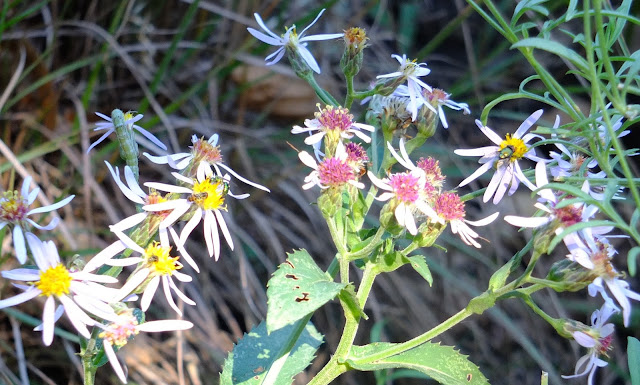We've had some nights in the lower 30s, that killed the ends of the tomato plants. We are still picking some tomatoes, though. Most of the flowering plants are finished blooming, but there is still some beauty out there, that I decided to post for Gail's Wildflower Wednesday. Some of the photos were taken around noon, when the sun was quite bright, and some around 6:30 in the evening, when it was near time to get dark.
The different liatrises are nice and fluffy. I saw a sparrow on one that was on the side of the house. I am not sure if I knew the birds ate these seeds. The color behind it is an amsonia hubrichtii.
Lead plant is such a slow grower when it is small, but is worth the wait.
Some of the big leaf asters are finished blooming, but some are still looking fresh. I'm not sure what the little insect is on one of the blooms.
I was surprised to see a few purple coneflowers blooming. I did have to pull some this summer due to aster yellows.
The Virginia mountain mints look good, even when going to seed.
The Illinois bundleflowers look their best when going to seed.
Cup plants are ones I've seen birds feed from all through the winter.
Our grandaughter loves the different goldenrod seedheads because they are fluffy. I don't remember what kind of beetle that is, but am thinking it is one I usually see on milkweed. It took off before I could get a clearer photo of it.
Aren't clematis pitcherii seed pots cool?
Deadheading the gray headed coneflowers prolonged their bloom time. When I bought the Liatris pyconostachya 'Eureka' I didn't notice the 'Eureka' written in pencil until I got it home. Oh, well, some of the other ones I have are also cultivars. It is shorter than other years.
Rattlesnake master is a fun plant to grow.
I am not sure what kind of goldenrod this is. It is one of Ruby's favorites.
The New England asters were one of the last to bloom, and I am sad they are about finished.
Round headed bushclover is another one that was a slow grower here. It bloomed last year, but was much shorter, and the blooms were smaller. I am tickled with how well the two plants did this year.
The short toothed mountain mint looks awesome all season, and usually has insect visitors on it.
I know I've shown most if not all of these plants in posts, but am not sure if I have shown them at this time of the season. I hope we all have some nice fall days before winter gets here.
The different liatrises are nice and fluffy. I saw a sparrow on one that was on the side of the house. I am not sure if I knew the birds ate these seeds. The color behind it is an amsonia hubrichtii.
Lead plant is such a slow grower when it is small, but is worth the wait.
Some of the big leaf asters are finished blooming, but some are still looking fresh. I'm not sure what the little insect is on one of the blooms.
I was surprised to see a few purple coneflowers blooming. I did have to pull some this summer due to aster yellows.
The Virginia mountain mints look good, even when going to seed.
The Illinois bundleflowers look their best when going to seed.
Cup plants are ones I've seen birds feed from all through the winter.
Our grandaughter loves the different goldenrod seedheads because they are fluffy. I don't remember what kind of beetle that is, but am thinking it is one I usually see on milkweed. It took off before I could get a clearer photo of it.
Aren't clematis pitcherii seed pots cool?
Deadheading the gray headed coneflowers prolonged their bloom time. When I bought the Liatris pyconostachya 'Eureka' I didn't notice the 'Eureka' written in pencil until I got it home. Oh, well, some of the other ones I have are also cultivars. It is shorter than other years.
Rattlesnake master is a fun plant to grow.
I am not sure what kind of goldenrod this is. It is one of Ruby's favorites.
The New England asters were one of the last to bloom, and I am sad they are about finished.
Round headed bushclover is another one that was a slow grower here. It bloomed last year, but was much shorter, and the blooms were smaller. I am tickled with how well the two plants did this year.
The short toothed mountain mint looks awesome all season, and usually has insect visitors on it.
I know I've shown most if not all of these plants in posts, but am not sure if I have shown them at this time of the season. I hope we all have some nice fall days before winter gets here.




















































